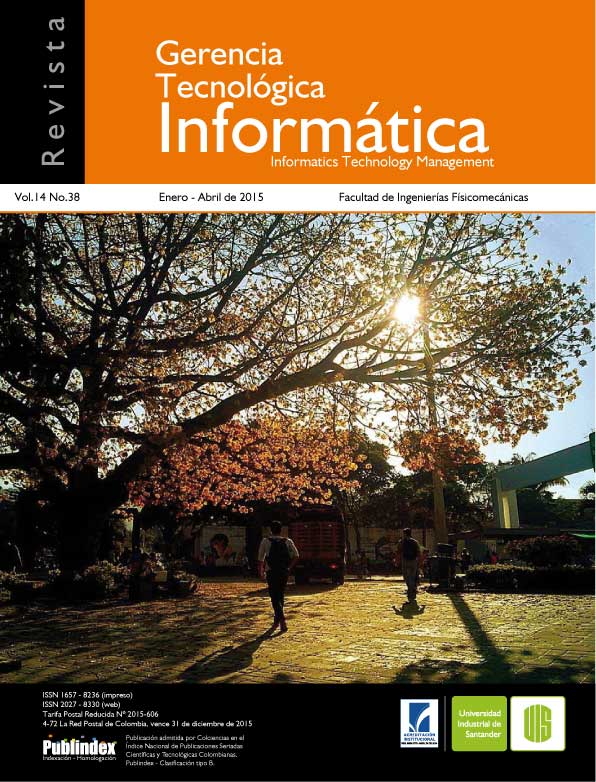Published 2014-10-28
How to Cite
Abstract
The software development is focused today on the management of changing requirements. The
development process should allow not only adapt to change but also to the reduction of effort, time
and costs, as well as to the promote of the scalability, the reliability and software reuse. That is why
the development of component-based software emerges as a line of software engineering that builds
and uses techniques for the implementation of open and distributed systems by assembling reusable
parts [17]. This article describes the principles of the Java Enterprise Edition (JEE) component
architecture and presents a practical implementation using Enterprise Java Beans (EJB’s), Richfaces,
Hibernate and Seam in its construction.
KEYWORDS: Software architecture, Software component, Java, EJB, Hibernate, JEE, Richfaces,
Seam, Stateless, Stateful, biyeccion, Facelets, Jboss
Downloads
References
- Alcaldía Mayor de Bogotá D.C. (2007). Acuerdo No.009 de 2007. Por el cual se reglamenta el Estatuto Docente de la Universidad Distrital en cuanto a políticas y procedimientos para el apoyo a la Formación Postgradual de alto nivel a Profesores de Carrera y se dictan otras disposiciones. Recuperado (2011, mayo 25) de http://www.alcaldiabogota. gov.co/sisjur/normas/Norma1.jsp?i=37242.
- Bijlsma, A., Heeren, B., Roubtsova, E., & Stuurman, S. (2011). Software Architecture. Free Technology Academy.
- Cheesman, J. & Daniels, J. (2001). UML Components. A Simple Process for Specifying Component-Based Software. EEUU: AddisonWesley, 2001.
- Java Bean. (2014, 1 de agosto). En Wikipedia, la enciclopedia libre. Recuperado el 1 de agosto de 2014 a las 6:15 p.m. de http://es.wikipedia.org/ wiki/JavaBean.
- Jendrock, E., Cervera-Navarro, R., Evans, I. et al. (2013). The Java JEE 6 Tutorial. Redwood City: Oracle and/or its affiliates. Recuperado (2014,agosto 1) de http://docs. oracle.com/javaee/6/tutorial/doc/.
- King, G., Bauer, C., Ebersole, S. et al. (2011) . Hibernate Developer Guide. Red Hat. Recuperado (2014, julio 30) de http://docs.jboss.org/ hibernate/core/4.0/devguide/en-US/html_single/.
- King, G., Muir, P., Richards, N. et al. (n.d.). Seam Contextual Components. A Framework for Entreprise Java. Recuperado (2014, julio 25) de http://docs. jboss.org/seam/2.3.0.Final/reference/en-US/html/.
- Koziolek, H., Becker, S., Happe, J., & Reussne, R. (2008). Life-Cycle Aware Modelling of Software Components. Component-Based Software Engineering, 11th International Symposium, CBSE (págs. 278-284). Karlsruhe, Germany: Springer.
- Linares, J. (2012). Desarrollo del prototipo de software SICAP (Sistema de seguimiento de capacitación y permisos docentes) de la Universidad Distrital Francisco José de Caldas, bajo la metodología RUP y desarrollado cobre arquitectura web JEE. Informe de pasantía no publicado. Universidad Distrital, Bogotá, Colombia.
- Morrison, R., Balasubramaniam, D., Oquendo, F., Warboys, B., & Greenwood, M. (2007). An Active Architecture Approach to Dynamic Systems Co_ evolution. First European Conference, ECSA (págs. 2-10). Madrid,Spain: Springer.
- Object Management Group (OMG). (2006). CORBA Component Model Specification; version 4.0; formal/06-04-01. Recuperado el 28 de 11 de 2014, de http://www.omg.org/spec/CCM/4.0/.
- Rosen, M., Lublinsky, B., Smith, K. T., & Balcer, J. M. (2008). Applied SOA: Service-Oriented Architecture and Design Strategies. Indianápolis: Wiley Publishing.
- Silberschatz, A., Korth, H., & Sudarshan, S. (2011). Database System Concepts. Sixth Edition. New York:McGraw-Hill.
- Sistema heredado. (2014, 1 de agosto). En Wikipedia, la enciclopedia libre. Recuperado el 1 de agosto de 2014 a las 5:30 p.m. de http:// es.wikipedia.org/wiki/Sistema_heredado.
- Sommerville, I. (2011). Software Engineering - 9th edition. EEUU: Addison Wesley.
- Szyperski, C. (2002). Component Software - Beyond Object-Oriented Programming. EEUU: Addison-Wesley / ACM Press.
- www.iupuebla.com. (2003). Desarrollo de Software Basado en Componentes. Capítulo 1. Recuperado (2014, agosto1) de http://www.iupuebla. com/Ingenieria/Sis_compu/MA_sistemas/MA_ PROGRAMACION_WINDOWS-sistema-basado-encomponentes-LAURA_MONARCA.pdf.
